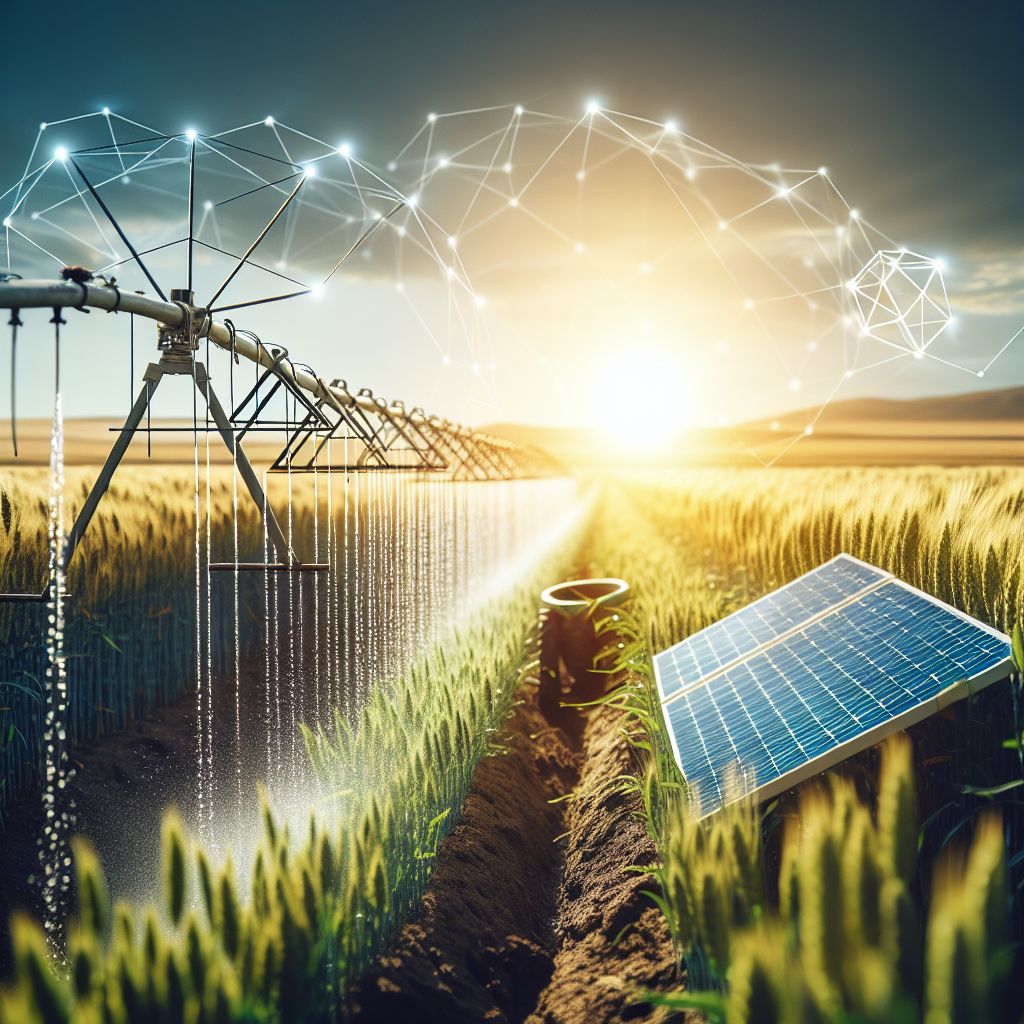
Key Takeaways
Through the use of solar irrigation systems, the amount of water and energy required to grow wheat can be significantly reduced.
It is essential to select the appropriate irrigation system in order to maximize efficiency and crop yields.
By understanding the water requirements of wheat at various stages of growth, irrigation schedules can be optimized.
Solar energy provides a sustainable power source for irrigation systems, reducing costs and increasing self-sufficiency.
Real-world examples demonstrate that the adoption of solar irrigation can result in successful farming, even under difficult conditions.
Water: The Lifeblood of Wheat Irrigation Efficiency
Let’s cut to the chase. Water is vital – particularly in the cultivation of wheat. But it’s not just about watering your crops; it’s about doing it intelligently. Wheat has unique water needs at different growth stages, and meeting these needs efficiently can mean the difference between a plentiful harvest and a failed one. This is where solar irrigation systems come in, offering a cost-effective and eco-friendly alternative to conventional irrigation methods.
How Much Water Does Wheat Need?
Let’s start by discussing how much water wheat needs. Wheat plants are similar to athletes in that they need a consistent supply of water to perform optimally. If they don’t get enough, they can’t grow properly, and if they get too much, you run the risk of disease or wasted resources. The goal is to provide the correct amount of water at the correct time. This is what efficient farming is all about, and it’s what we’re striving for.
Using Technology for Sustainable Agriculture
Let’s talk about technology. Solar irrigation isn’t just a buzzword; it’s a game-changer for sustainable farming. By using the sun’s power, we can pump water to our wheat fields without needing the grid or burning fossil fuels. This results in lower energy costs, less carbon emissions, and more savings in the long term. And the best part? The sun’s energy is completely free.
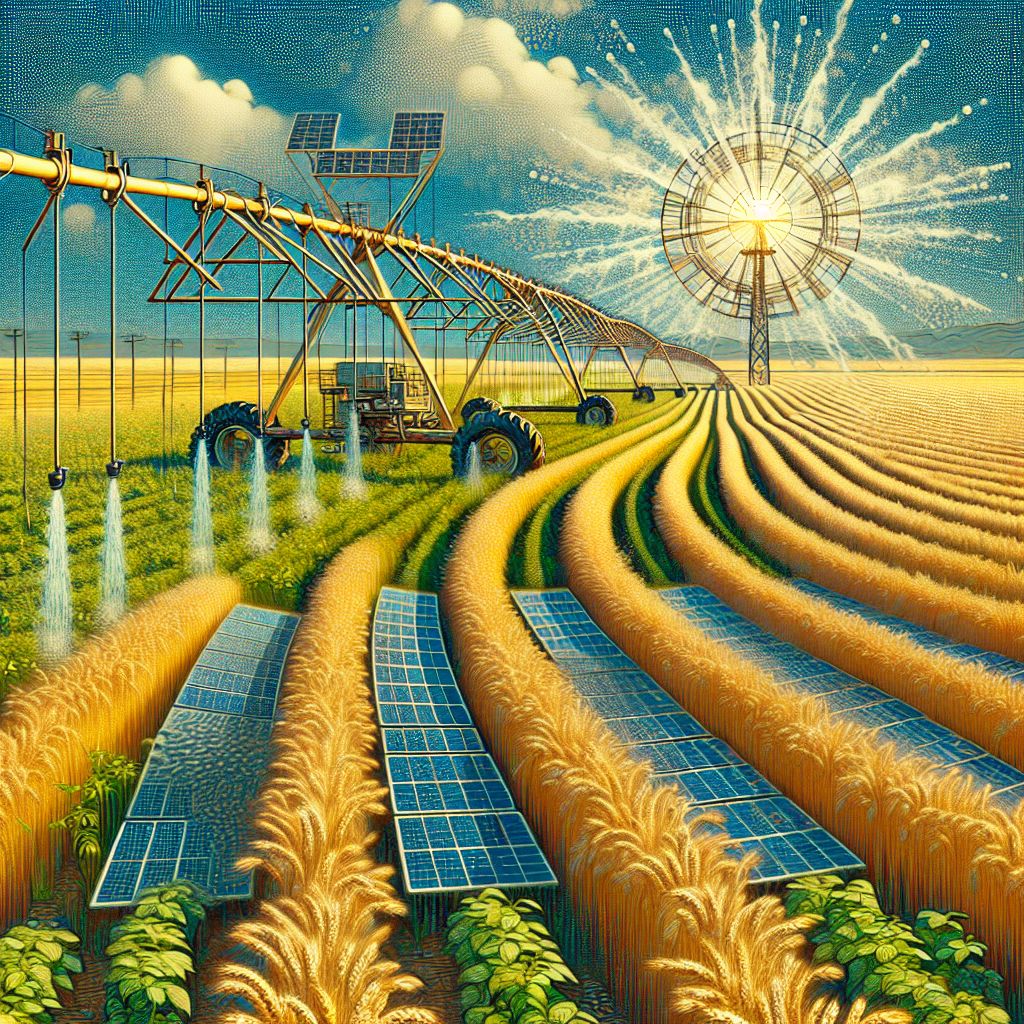
Picking the Perfect System: A Wheat Grower’s Handbook
How do you select the perfect solar irrigation system for your wheat farm, though? It’s about getting to know your land and the needs of your crop. You’ll need to think about things like how big your farm is, what the weather is like in your area, and what kind of soil you have. Let’s take it one step at a time.
Evaluate the layout of your farm and the availability of water sources.
Estimate the water needs of your wheat crop for the entire growing season.
Consider your local weather conditions – more sunlight means more solar power to pump water.
This table will show you the top irrigation systems for growing wheat:
|
Irrigation System |
Reasons |
|---|---|
|
Sprinkler Irrigation |
– Suitable for a wide range of soil types, including sandy soils with high infiltration rates5 |
|
Drip Irrigation |
– Efficient in water usage, applying water directly to the roots of the plants. 1, 3, 5 |
|
Center Pivot Irrigation |
– The most widely used irrigation system for wheat and other crops in Georgia. 1 |
Sprinkler and drip irrigation are more efficient in water usage and distribution, which is important for wheat’s moderate to high irrigation requirements. 1, 3
Center pivot irrigation is the most commonly used system for wheat and other crops, providing even water application over a large area. 1
The choice also depends on factors like soil type, topography, water availability, and the farmer’s previous experience with irrigation. 5
Drip Irrigation: Making Every Drop Count
Drip irrigation is like providing each of your wheat plants with its own water bottle. It delivers water straight to the roots, where it’s most needed, reducing waste and evaporation. This system is perfect for smaller farms or areas with water shortages. Moreover, when it’s powered by solar energy, it’s incredibly efficient and eco-friendly.
Sprinkler Systems: The Right Choice for Large Areas
For those with a larger area to irrigate, a solar-powered sprinkler system may be the best choice. This system mimics rainfall to provide even water distribution across your field. However, it’s crucial to use this system carefully to avoid water loss due to wind and evaporation. To make the most of your water, try to time your irrigation for early morning or late evening when the sun is low and the wind is usually at its calmest. For a deeper understanding of irrigation’s impact on wheat, consider reviewing wheat physiology, grain yield, and quality.
The Circular Efficiency of Center Pivot Irrigation
Another option is the center pivot system. This system operates like a large rotating sprinkler that spins around a central point in your field. It works best for large, circular fields. When you combine this system with solar power, it can be a very efficient way to water your wheat. The key to this system is precision – ensuring that every drop of water is used to its maximum potential.
Consider a farmer from Kansas who switched to a solar-powered center pivot system. He experienced a 20% increase in his wheat yield and reduced his water usage by 25%. Now that’s what I call efficiency.
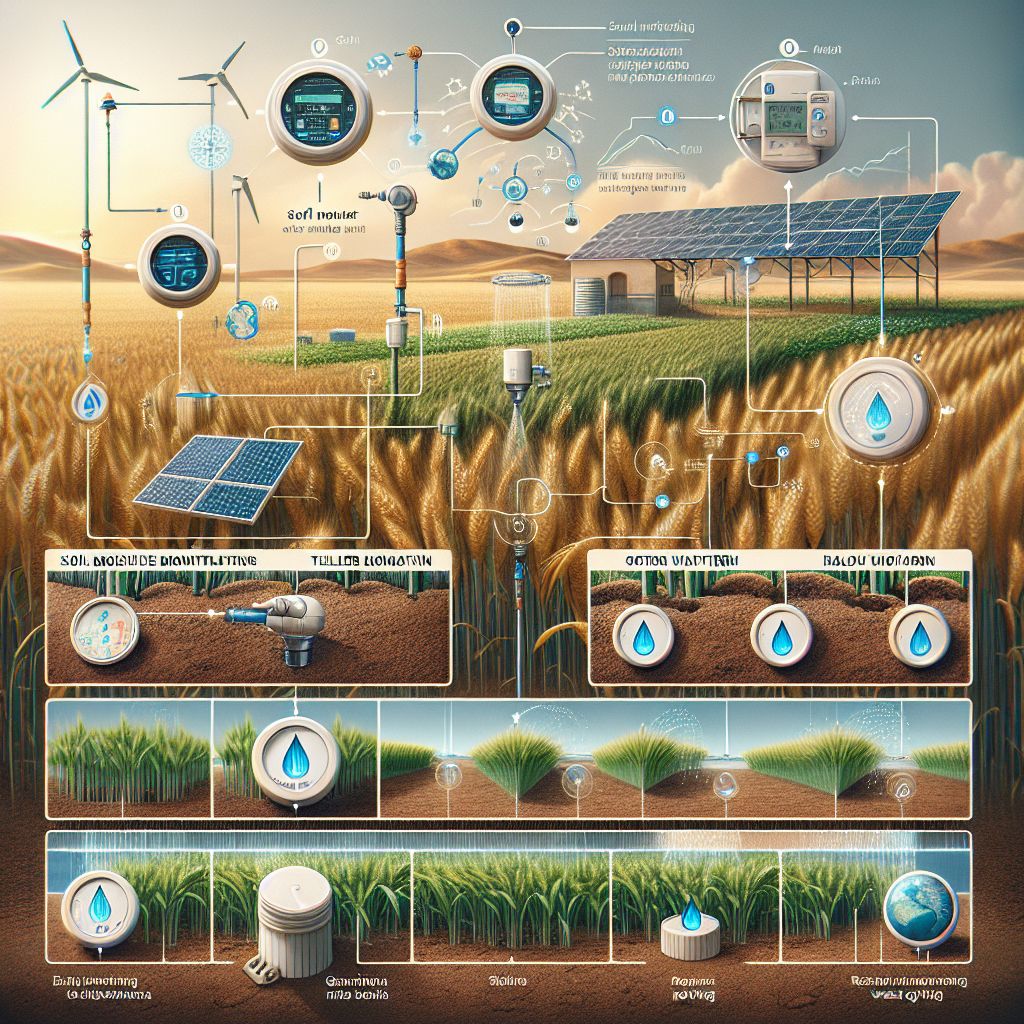
Smart Watering Techniques for Thriving Wheat
Smart watering techniques are essential for thriving wheat crops. By implementing efficient irrigation systems and utilizing soil moisture monitoring, evapotranspiration-based scheduling, and other innovative methods, farmers can optimize water use, enhance wheat productivity, and ensure sustainable agricultural practices. Adopting these techniques will not only benefit wheat production but also contribute to water conservation and environmental stewardship.
Understanding the Water Requirements of Wheat
Wheat is a bit of a Goldilocks when it comes to water; it doesn’t like to be waterlogged, but it does need a steady supply of water, especially during critical growth periods like germination, tillering, and heading. On average, wheat needs between 12 and 15 inches of water over the course of its growth cycle. That’s why it’s so important to keep an eye on soil moisture levels and to provide water exactly when and where it’s needed. For more in-depth information on this, read A Review on Regulation of Irrigation Management on Wheat Physiology, Grain Yield, and Quality.
First and foremost, you need to think about how effective your watering methods are. Traditional irrigation methods can be wasteful, with a lot of the water evaporating or running off. By incorporating solar power into your irrigation system, you’re not only conserving water, but you’re also conserving energy.
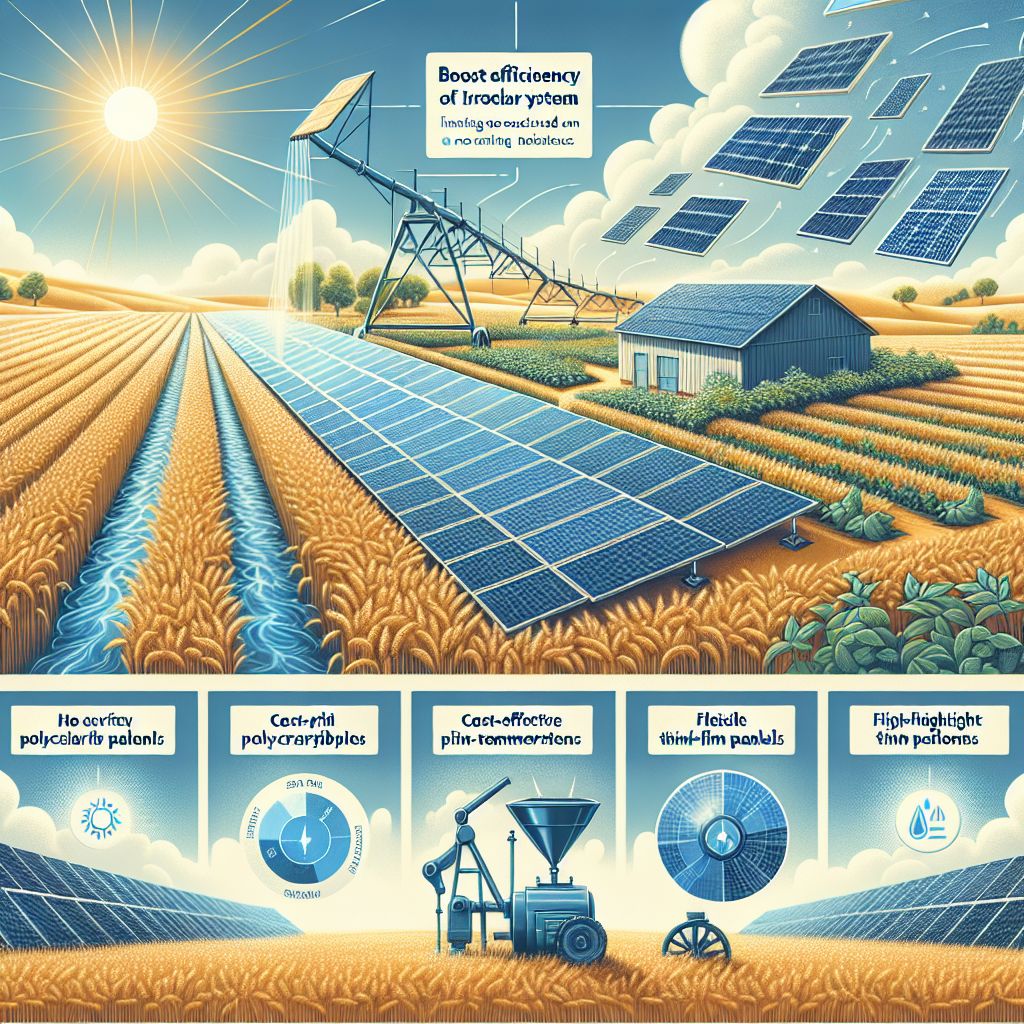
Boost Your Irrigation System’s Efficiency with Solar Panels
Here’s where the sun comes into the picture. Solar panels can be used to power your irrigation pumps, reducing or even completely removing the need for grid electricity or diesel. By using solar panels, you’re harnessing a renewable energy source that’s plentiful, especially in the sunny fields where wheat grows best.
Consider the Various Solar Panel Options for your Irrigation System
Solar panels come in a variety of types. Monocrystalline panels are known for their high efficiency and excellent performance in low-light conditions. Polycrystalline panels are a cost-effective choice that performs well in high-temperature environments. Thin-film panels are flexible and lightweight, but they take up more space. Factors such as your location, budget, and the size of your irrigation system will determine which type is best for you.
Choosing the Right Solar Panel for Your Irrigation System
Just like you would carefully select the right seed for your soil, you should also carefully select the right solar panel for your irrigation system. You need to consider the power requirements of your irrigation system, the amount of sunlight your location receives, and the space available for installing the panels. It’s always a good idea to consult with a solar expert to find the perfect fit for your farm.
As solar panels come in a variety of sizes and power levels, you’ll need to work out the total wattage required to power your pumps. From there, you can figure out how many panels you’ll need to meet this requirement. Keep in mind that choosing a solar-powered irrigation system is a long-term commitment that can result in substantial energy cost savings in the long run.
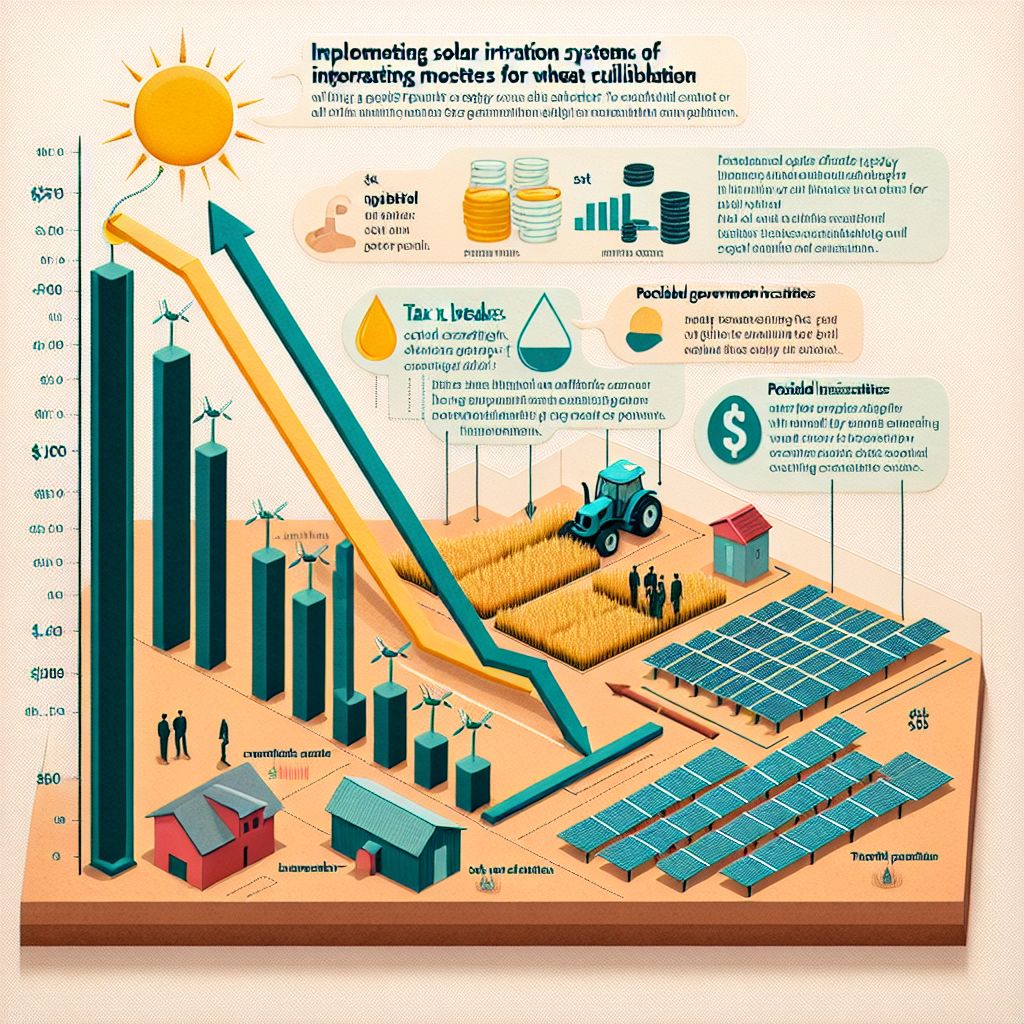
Running the Numbers: Cost-Benefit Analysis
Th cost-benefit analysis of implementing solar irrigation systems for growing wheat reveals a promising solution to the challenges posed by water scarcity and climate change. By providing a sustainable and cost-effective alternative to traditional irrigation methods, solar irrigation systems can help farmers maintain their crop yields while minimizing their environmental impact. While there are some challenges and considerations to be aware of, the long-term benefits of solar irrigation systems make them a worthwhile investment for farmers looking to adapt to the changing agricultural landscape.
Understanding the Upfront Cost
Discussing finances can be a bit tricky. The upfront cost of solar panels might appear high, but keep in mind, this is a one-time expense that will provide ongoing advantages. For a small irrigation system, the cost for solar panels and installation could be anywhere from a couple thousand dollars to several tens of thousands for larger systems.
How Solar Solutions Can Save You Money in the Long Run
Now, let’s get to the exciting part. Solar irrigation systems can help you save a significant amount of money on energy costs in the long run. Additionally, you can often find government incentives, tax breaks, and grants for investing in renewable energy. These can greatly decrease your initial costs and help you see a return on your investment more quickly.
The Advantages of Solar Energy over Conventional Energy for Irrigation
When you compare solar energy to traditional energy sources, the advantages are obvious. Solar energy is free after the infrastructure is in place, while fossil fuels are only going to become more expensive. Solar energy is clean, producing no emissions, whereas traditional energy sources can be heavy polluters. In the long run, solar energy is the smarter choice for both your wallet and the environment.
This table compares the use of solar energy versus conventional energy sources for irrigation in wheat cultivation:
|
Comparison Factor |
Solar Energy for Irrigation |
Conventional Energy (Diesel/Grid) for Irrigation |
|---|---|---|
|
Water Usage Efficiency |
– Solar irrigation systems, especially drip and sprinkler, are more efficient in water usage compared to conventional methods. 2, 3 |
– Conventional irrigation systems like surface irrigation tend to be less efficient in water usage. 2, 3 |
|
Emissions and Environmental Impact |
– Solar irrigation displaces fossil fuel use and reduces greenhouse gas emissions. 2 |
– Diesel-powered irrigation pumps contribute to significant greenhouse gas and air pollutant emissions. 4 |
|
Operational Costs |
– Low operational costs as there are no fuel expenses. 4 |
– High operational costs due to fuel (diesel) or electricity expenses. 4 |
|
Initial Investment |
– High upfront capital costs for solar PV and irrigation equipment. 4 |
– Lower initial investment compared to solar, but higher long-term operating costs. 4 |
|
Payback Period |
– Payback periods can range from 6 months to 3 years, depending on crops and number of cycles. 2 |
– Payback periods are generally longer than solar, around 2.6 years in one study. 2 |
|
Reliability and Resilience |
– Solar systems are reliable and not subject to grid or fuel supply disruptions. 2 |
– Conventional systems are vulnerable to grid outages or fuel supply issues. 2 |
|
Socioeconomic Benefits |
– Improves farmer incomes, reduces manual labor, and enhances food security. 2 |
– Limited socioeconomic benefits compared to solar irrigation. 2 |
Solar irrigation systems offer greater water and energy efficiency, lower emissions, and better long-term cost-effectiveness compared to conventional diesel or grid-powered irrigation for wheat cultivation. However, the high upfront costs remain a barrier to wider adoption, especially for small-scale farmers.

Real-World Success: Farmers Flourishing with Efficient Irrigation
In California’s farming belt, a wheat farmer switched to solar-powered irrigation, reducing his energy costs by 75% without affecting crop yields. More and more farmers are experiencing such success as they discover the advantages of solar power.
This is not a one-off. Farmers worldwide are adopting solar irrigation to counter increasing energy costs and water shortages. In doing so, they’re not just surviving; they’re thriving, producing abundant crops while protecting the environment for future generations.
Using solar energy for irrigation isn’t just a new fad, it’s a step towards farming in a way that’s smart and sustainable. We can use the sun’s energy to provide the water our crops need without using up natural resources or hurting the Earth. It’s a solution that’s good for both farmers and the planet.
Case Study: Beating the Drought through Creativity
In Australia, a wheat farmer dealing with intense drought conditions resorted to solar-powered drip irrigation. By doing this, he managed to keep production levels steady despite the lack of water. This creative solution not only saved his farm but also acted as a blueprint for nearby farms dealing with the same problems.
Feature: High Output with Less Water Consumption
But it’s not just about making it through the hard times. In India, a group of wheat farmers increased their yields by 30% while decreasing their water usage by 40% by using solar-powered irrigation. These farmers are now leading the way in their communities, showing that sustainable practices can lead to improved crop performance and profitability.
Highlight: Increased Harvests with Decreased Water Use
It’s not just about making it through the hard times. In India, a group of wheat farmers have used solar-powered irrigation to increase their harvests by 30% while decreasing their water use by 40%. These farmers are now leading the way in their communities, showing that sustainable practices can lead to better crop yields and profitability.
Boosted crop production by 30%.
Decreased water consumption by 40%.
Embraced solar irrigation as an eco-friendly approach.
These are more than just success stories; they are proof of the potential of inventive and flexible farming techniques. By adopting solar irrigation, farmers are paving the way for the future of agriculture, demonstrating that it is feasible to generate more with less in a manner that is beneficial to our environment.
So, if you’re thinking about changing to solar irrigation, these success stories are a strong testament to its advantages. They not only show the possibility for cost reduction and improved efficiency, but also the positive effect on crop production and water preservation. It’s evident that solar irrigation is a wise investment for the future of agriculture.
Final Thoughts:
Wrapping up, solar irrigation systems are a game-changer for wheat farmers who want to make the most out of their water usage and reduce energy expenses. By knowing the unique needs of wheat and using the appropriate solar-powered irrigation system, farmers can reap bountiful harvests, lower costs, and promote a greener environment.
Efficient water management in wheat farming has its obstacles, but it is a journey that is worth undertaking with the right knowledge and tools. Solar irrigation systems are not just a small part of the solution—they are a significant shift towards sustainable agriculture.
FAQs
Do you have questions? I have answers. Here are some frequently asked questions about solar irrigation systems for wheat farming:
What should I consider when selecting a solar irrigation system for my wheat crop?
When selecting a solar irrigation system for your wheat crop, it’s essential to consider your farm’s unique needs. Think about the size of your farm, the local weather conditions, and how much water your wheat needs at different stages of its growth. Speak with a solar professional and choose a system that fits both your watering needs and your budget.
Take a good look at the layout of your farm and the availability of your water sources.
Work out how much water your wheat crop will need.
Get advice from a solar expert to find the best system for your farm.
Keep in mind, the aim is to give your wheat the right amount of water at the right time, using the sun’s sustainable energy. This will not only improve the health and yield of your crop, but it will also lower your carbon footprint and energy bills.
Is it possible for small-scale farmers to afford efficient solar irrigation systems?
Indeed, efficient solar irrigation systems can be within reach for small-scale farmers. Although the upfront investment may appear intimidating, there are usually government incentives, grants, and financing options available that can help to mitigate the costs. Moreover, the long-term savings on energy bills make solar irrigation a financially sound decision over time.
In addition, there are solar irrigation systems that can be adjusted to the size of smaller farms, so that even small-scale farmers can benefit from this technology.
How does efficient solar irrigation affect the quality of grain?
Grain quality can be significantly improved with efficient solar irrigation. By delivering water in a precise and consistent manner, solar irrigation systems can prevent wheat crops from experiencing stress due to drought or overwatering, which can impact the development of the grain. This leads to higher-quality yields, with improved texture, taste, and nutritional value.
Does the government provide incentives for solar irrigation systems?
Yes, many governments offer incentives like tax credits, rebates, and grants for using solar irrigation systems. They do this to encourage farmers to use renewable energy, which helps the environment and reduces our reliance on non-renewable energy sources. Check with your local and national government to see what incentives are available to you.
How do I determine the precise water requirements of my wheat crop?
By using soil moisture sensors, evapotranspiration data, and weather forecasts, you can determine the precise water requirements of your wheat crop. By monitoring soil moisture levels, you can ensure that you are providing just the right amount of water to meet the needs of your crop without over-irrigating. This method allows you to use water more efficiently, resulting in healthier plants and improved yields.







Leave a Reply